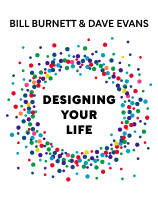

This article is an excerpt from the Shortform book guide to "Designing Your Life" by Bill Burnett and Dave Evans. Shortform has the world's best summaries and analyses of books you should be reading.
Like this article? Sign up for a free trial here .
What’s your work philosophy? How would you spend your time if money were no object? Whom would you trust to help you design your life?
In Designing Your Life, Stanford professors Bill Burnett and Dave Evans share the content of their popular courses and workshops on life design. Using concrete principles and examples, they teach readers how to design a meaningful life in which they can truly thrive.
Continue reading to find several Designing Your Life exercises that will help you apply the book’s concepts.
Designing Your Life Exercises
Everyone wants to make a living doing meaningful work that harmonizes with their values and makes them happy. But, many people feel stuck in the wrong life doing unfulfilling work with no way out. Some hope that if only they can find their “true passion,” everything will magically fall into place. Both attitudes—the defeated one and the magical passion one—are false. What we need is a clear-cut process for designing our lives—a learnable approach to building a fulfilling career.
The following nine Designing Your Life exercises will help you implement this process in your own life.
Exercise #1: Create Your Life Dashboard
Chapter 1 introduced you to the idea of a “life dashboard” consisting of four “gauges” to help you identify your current situation and the problem that you need to address through life design. This exercise leads you through creating your personal dashboard.
- Write several sentences describing how things are going for you in the four areas of health, work, joy, and relationships. Use specific details, but be succinct.
- Assign each area a percentage to indicate how full you are in that area.
- How are the balance and proportionality among the different gauges? (Are the readings pretty close to each other? Or are there wide differences?)
- Based on your dashboard, how well is your life running overall? What can you already recognize as problem areas that can benefit from applying design principles?
Exercise #2: Build Your Life Compass
Chapter 2 introduced you to the “life compass,” which consists of your work philosophy and your life philosophy. This exercise leads you through the process of creating this tool.
- Briefly write out your work philosophy (up to 250 words). What do you think work means? What is it for? How does work relate individuals to society? What makes work good or worthwhile? Does it involve service to others? What’s the place of money? Does it have anything to do with fulfillment, growth, or the use of talents?
- Briefly write out your life philosophy (up to 250 words). What is life’s meaning? Why are you (and everybody else) here? What’s the relationship among individuals and family, country, and humankind? What are good and evil? Is there a God or higher power? What’s the role in human life of such things as justice, injustice, love, hatred, and conflict?
- Where do your work and life philosophies complement each other?
- Where do your work and life views clash with each other? (If noticing these clashes makes you want to go back and revise what you’ve written, feel free. Just make sure you write your philosophies honestly, stating how you really see and think about things.)
Exercise #3: Practice Your Wayfinding Skills
Chapter 3 told you how to create a journal to help you practice the art of wayfinding in your life. This exercise will help you to practice the skills involved in keeping that journal.
- Think of an activity where you felt both involved and energized. Ideally, think of one where you experienced flow. What was the activity?
- What aspects of the activity created a sense of involvement, flow, and energy? Use the four question sets (who, what, where, and interactions) to “zoom in” with your reflections.
- Think of an activity where you felt uninvolved and drained. State what it was and perform the same reflection exercise on it.
- What can you do this week to act on these findings? For example, can you strategize your schedule more effectively to maximize your involvement and energy and minimize or mitigate your boring and draining activities?
Exercise #4: Generate Ideas With a Mind Map
Chapter 4 taught you how to create mind maps to generate creative solutions to problems. This exercise will lead you through reflecting on what you can learn by doing this.
- Create a mind map as described in the chapter. What did you choose as your central topic?
- What are the second-layer words and ideas that you wrote about your central topic?
- What are the third-layer (and, if applicable, fourth-layer) words and ideas that you built out from the second-layer ones?
- What did you learn when you combined ideas from the outermost layer of your mind map? What creative solutions to your problem did you come up with? What ideas from your subconscious mind did this exercise bring to light?
Exercise #5: Plan Your Adventure Plans
Chapter 5 taught you how to create three different adventure plans for your life. This exercise helps you to get started on doing that.
- Your first plan should focus on your current life (imagined five years forward) or an idea that you’ve already been developing. What is this plan? Give it a six-word title.
- Your second plan imagines what you’d do if your current work world disappeared. Your third imagines what you’d do if money and reputation didn’t matter. What will you select for these plans? Give each a six-word title. Consider drawing on ideas from your Wayfinding Journal.
- You can probably already imagine some questions that each of these plans will raise—about feasibility, funding, or any number of other factors. What are some of these questions?
- Commit to actually creating your three plans this week using the format provided in the chapter. For now, consider what you’ll enter in the dashboard for each plan. How “full” do you think the gauges for resources, like level, confidence, and coherence will be?
Exercise #6: Practice Prototyping
In Chapter 6, you learned how to prototype alternative designs for your life. This exercise guides you through the initial process of practicing this skill.
- Review your three Adventure Plans. Pay special attention to the questions you wrote for each. Pick one of these plans that really excites you. What are the questions you wrote for it?
- Make a list of life interviews that could help you answer these questions. Use mind mapping if it helps you get ideas.
- Make a list of exploratory experiences that could help you answer the questions. Again, use mind mapping if it helps you get ideas.
- Who could you approach about forming a brainstorming team for life design prototyping? Write down the names of two to four people, noting why each would be a good choice.
Exercise #7: Reframe Your Failures
In Chapter 10, you learned a method for reframing failures. This exercise leads you to try it out.
- Look back over your last week or month (your choice). What failures have you made? Be sure to include one or more that represent improvement opportunities.
- Categorize these failures as screw-ups, weaknesses, or improvement opportunities.
- What are your improvement insights?
- How can you productively integrate this exercise into your regular schedule? What will be the best rhythm for you (once a month, twice a month)? Why?
Exercise #8: Create Your Team
In Chapter 11, you learned about creating a life design team. This exercise will help you get started.
- Who are some of the major presences in all three categories of your general team: allies, key players, and intimates? List as many as you can think of.
- List three to five people from the longer list above who might be good candidates for your specific team. Focus especially on anyone who is actively involved in designing their own life.
- What could you do this week to start drawing together this team? (Send emails? Make phone calls? Visit people personally?)
- What exactly do you plan to say to each potential team member? How will you make your invitation sound truly inviting?
Exercise #9: Assess Your Design Attitudes
The book’s conclusion reminded you of the five design attitudes and recommended that you commit to a specific practice for remaining in touch with your whole being (not just your intellect). This exercise leads you to begin planning these things.
- For designing your life, what do you presently need to know? What would you like to explore? State these things as questions, and list at least two specific ways you could intelligently pursue the answers this week.
- What defective beliefs has this book uncovered in your mind? How can you reframe them right now?
- What steps can you start pursuing, beginning tomorrow, to implement the lessons in this book?
- If you already have a practice such as prayer or yoga, how can you integrate it in a mutually enhancing way with your life design efforts? If you don’t currently have such a practice, which one sounds the most attractive to you—meditation, prayer, yoga, tai chi, journaling, or something else?—and what can you do to begin it right away?

———End of Preview———
Like what you just read? Read the rest of the world's best book summary and analysis of Bill Burnett and Dave Evans's "Designing Your Life" at Shortform .
Here's what you'll find in our full Designing Your Life summary :
- Why finding your "true passion" in life is a myth
- The five mental attitudes in design thinking
- How to design a meaningful life in which you can truly thrive






